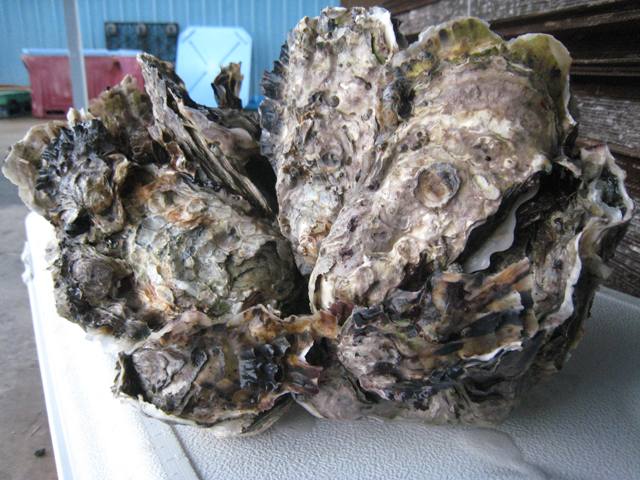How we farm: shucked oysters!
Here are the oysters spawning earlier this summer:
And now here are their babies!
The black specks on this shell are miniature oysters, called spat. In 3 to 5 years they'll be big enough to shuck and eat.
Oyster farmers in the Hood Canal are lucky to be able to farm wild oysters. A "farmed but still wild" operation challenges a bunch of assumptions that we don't need to explore in this post... just know that it's a really beautiful way to grow food. We basically work to make our beach more habitable for the things we want to eat, like some kind of aquatic food forest.
During the metamorphosis from zooplankton to sedentary animal an oyster is attracted to oyster shell... this means baby oysters are most likely to attach to oyster shell. From an evolutionary standpoint this makes sense... the juvenile oysters want to live where other oysters have successfully lived. But anything out on the beach during setting season is potential oyster habitat... we've seen oysters growing on leather, metal, wood, and even a plastic snake.
Through the ages and across the world, farmers have used various materials to entice oysters to their beach. On a recent vacation in Vietnam, we found oyster farmers growing oysters on slate roofing tiles. From the mid-50s to early 60s, when our oyster farm was first getting established, oyster shell was scarce, so we used concrete covered lath to mimic the chemical composition of oyster shell. The oysters would attach to the wood, eventually the wood would break apart, and we could spread the oysters on the beach to continue growing.
As soon as we had enough shells (starting in the the late 60s and throughout the 70s, 80s, and early 90s) we suspended bags of oyster shell (called cultch) from floating racks out in the middle of the Canal. Deploying the "seed racks" was a pretty big undertaking, one that took the whole family. It was a fun (albeit dangerous!) job on sunny August afternoons. Here are the racks up on shore:
And here they are floating out in the water:
In the late 90s, the permitting for the seed racks got pretty complicated and we decided we'd rather not use so much styrofoam. Since then we've gone back to basics: in the springtime we bag shell up into cultch bags (we try to get this done before the Oyster Rama, and then we use the cultch bags for our Rama fence) and when the oysters spawn in July or August, we put pallets of cultch bags out on the beach in hopes they'll attract larvae at high tide.
Sometimes this works. But nothing's a given! Sometimes the wind picks up during the larval period, drops the water temperature, and everything dies. Here are year old oysters growing on cultch bags:
And here's a 5 to 7 year old oyster cluster, the end result of this process:
Since Hood Canal has such a prolific wild oyster population, Canal farmers were a little slow to embrace hatchery seed. Why pay for something you get for free? Of course, using seed produces a much higher quality product for the half shell market, more reliable in shape, size, and appearance. And for the past 6 years or so the wild oysters really haven't reproduced in the Canal, so we've had to scramble to get our seed operations up and running. The lack of a natural set may be normal (we did have a big set in 2012) or it may be related to ocean acidification... the Canal has seen some of the lowest pH ever recorded on earth. To learn more about how to grow oysters from seed, read this post.











2 comments
[…] Spawn, spat, set. Read more about it here. […]
[…] this happen? Oysters reproduce naturally in Hood Canal, which makes this a really darn good place to farm oysters. After the spawn, baby […]